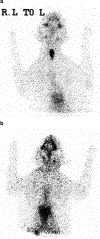Feline thyroid carcinoma: diagnosis and response to high-dose radioactive iodine treatment
- PMID: 18835538
- PMCID: PMC10832792
- DOI: 10.1016/j.jfms.2008.02.010
Feline thyroid carcinoma: diagnosis and response to high-dose radioactive iodine treatment
Abstract
This study reports the scintigraphy, histopathology, sole treatment with high-dose radioactive iodine and outcome of eight cases of feline thyroid carcinoma. Scintigraphic findings were variable and in 7/8 cases scintigraphic features could not reliably distinguish whether the thyroid tissue was malignant. Histopathology revealed typical criteria of malignancy in all cases, with mitotic activity described most frequently (7/8 cases), followed by infiltration of local tissues (4/8 cases). Cellular pleomorphism was infrequently observed. Single high-dose (1100MBq I(131)) radioiodine therapy was successful in 6/8 cases, with complete resolution of hyperthyroidism, and was associated with prolonged survival times (181-2381 days). Sole treatment with high-dose radioiodine is a safe and effective treatment for functional thyroid carcinoma. The prognosis for feline thyroid carcinoma successfully treated with radioiodine is good, with extended survival times commonly achieved.
Figures







References
-
- Feldman E.C., Nelson R.W. Feline hyperthyroidism (thyrotoxicosis), Canine and Feline Endocrinology and Reproduction, 3rd edn, 2004, Elsevier Science: USA, 152–218.
-
- Naan E.C., Kirpensteijn J., Kooistra H.S., Peters M.E. Results of thyroidectomy in 101 cats with hyperthyroidism, Vet Surg 35 (3), 2006, 287–293. - PubMed
-
- Holzworth J., Theran P., Carpenter J.L., Harpster N.K., Todoroff R.J. Hyperthyroidism in the cat: Ten cases, J Am Vet Med Assoc 176 (4), 1980, 345–353. - PubMed
-
- Hoenig M., Goldschmidt M.H., Ferguson D.C., Koch K., Eymontt M.J. Toxic nodular goitre in the cat, J Small Anim Pract 23, 1982, 1–12. - PubMed
-
- Turrel J.M., Feldman E.C., Nelson R.W., Cain G.R. Thyroid carcinoma causing hyperthyroidism in cats: 14 cases (1981–1986), J Am Vet Med Assoc 193, 1988, 359–364. - PubMed
Publication types
MeSH terms
Substances
LinkOut - more resources
Full Text Sources
Medical

